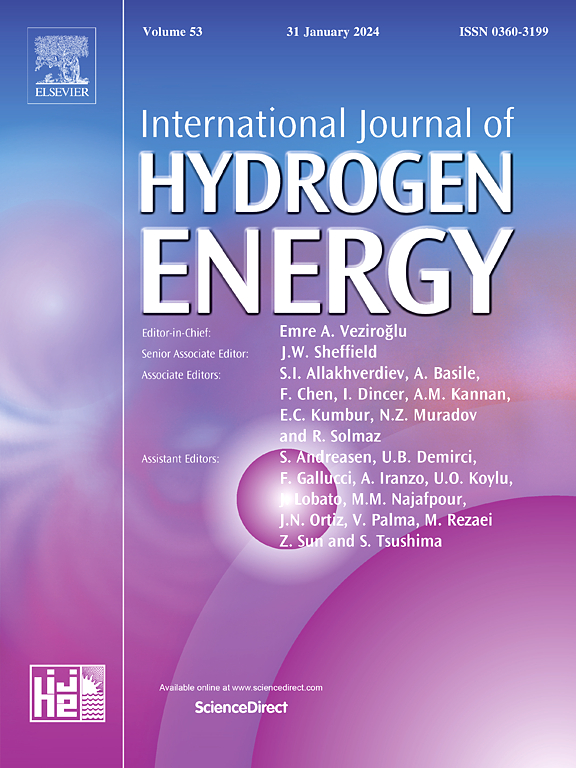从日出到日落的连续制氢:通过界面工程纳米复合材料tris-s-三嗪g-C3N4/ZnIn2S4异质结构提高光催化稳定性
IF 8.1
2区 工程技术
Q1 CHEMISTRY, PHYSICAL
引用次数: 0
摘要
在不同光照强度下的批量实验和全天实验中,首次实现了三-s-三嗪g-C3N4/ZnIn2S4异质结光催化剂从日出到日落连续制氢。晴空条件下,从上午6点到下午1点H2产量稳步增加,下午1点达到峰值13.6 mmol h−1·g−1cat,下午开始下降。阴天条件下,产氢速率较慢,在下午1点达到峰值,为3.1 mmol h−1·g−1cat,这表明光强和光谱组成对太阳能制氢效率的影响。不同时段H2产率依次为:12 ~ 3 pm;上午9-12点下午3-6点两种天气都是早上6点到9点。该纳米杂化光催化剂在400 ~ 500 nm范围内具有较强的可见光吸收能力,在太阳活动高峰时段(上午10:30 ~下午2:30)H2生成速率达到10.9 mmol h−1·g−1cat。它还在多个光反应器中连续5天保持了稳定的氢气生产,表明了其工业规模扩大的潜力。利用x射线衍射和透射电镜证实了异质结的形成,而光致发光、光电流密度和电化学阻抗谱结果证实了有效的载流子分离。漫反射紫外-可见光谱、x射线光电子能谱、Mott-Schottky和电子顺磁共振光谱分析证实,s型结使得具有高能量势的电子和空穴可用于氧化还原反应,同时也有利于低能量势的电子和空穴的复合;这些工艺共同促进了载流子的分离,提高了H2的产量。这项研究为电子转移动力学、太阳光谱可见波段和光强对可持续H2生产的影响提供了有价值的见解。本文章由计算机程序翻译,如有差异,请以英文原文为准。

Continuous hydrogen production from sunrise to sunset: Advancing photocatalytic stability via interface-engineered nanocomposite tris-s-triazine g-C3N4/ZnIn2S4 heterostructure
A tris-s-triazine g-C3N4/ZnIn2S4 heterojunction photocatalyst achieved continuous H2 generation from sunrise to sunset for the first time, based on batch and day-long experiments at different sunlight intensities. Under a clear sky, H2 production increased steadily from 6 a.m. to 1 p.m., peaking at 13.6 mmol h−1·g−1cat at 1 p.m. before declining in the afternoon. Under a cloudy sky the H2 production was slower, reaching a peak rate of 3.1 mmol h−1·g−1cat at 1 p.m., highlighting the influence of light intensity and spectral composition on the solar-to-hydrogen conversion efficiency. H2 production rates in different time slots follow the order of 12–3 p.m. > 9–12 a.m. > 3–6 p.m. > 6–9 a.m. under both sky conditions. This nanohybrid photocatalyst showed enhanced visible light absorption (400–500 nm) and a peak H2 generation rate of 10.9 mmol h−1·g−1cat during peak solar hours (10:30 a.m. to 2:30 p.m.). It also maintained consistent H2 production across multiple photoreactors and over five consecutive days, indicating its potential for industrial scale-up. The formation of heterojunction was confirmed using X-ray diffraction and transmission electron microscopy, whereas photoluminescence, photocurrent density, and electrochemical impedance spectroscopy results demonstrated effective charge carrier separation. Diffuse reflectance ultraviolet–visible spectroscopy, X-ray photoelectron spectroscopy, Mott–Schottky and electron paramagnetic resonance spectroscopy analyses confirmed that the S-scheme junction makes electrons and holes from higher energy potential available for redox reactions and at the same time facilitates recombination of electrons and holes of lower energy potential; combinedly these processes facilitate separation of charge carriers and improve H2 production. This study provides valuable insights into the electron transfer dynamics, influence of the visible band of solar spectrum, and light intensity on sustainable H2 production.
求助全文
通过发布文献求助,成功后即可免费获取论文全文。
去求助
来源期刊

International Journal of Hydrogen Energy
工程技术-环境科学
CiteScore
13.50
自引率
25.00%
发文量
3502
审稿时长
60 days
期刊介绍:
The objective of the International Journal of Hydrogen Energy is to facilitate the exchange of new ideas, technological advancements, and research findings in the field of Hydrogen Energy among scientists and engineers worldwide. This journal showcases original research, both analytical and experimental, covering various aspects of Hydrogen Energy. These include production, storage, transmission, utilization, enabling technologies, environmental impact, economic considerations, and global perspectives on hydrogen and its carriers such as NH3, CH4, alcohols, etc.
The utilization aspect encompasses various methods such as thermochemical (combustion), photochemical, electrochemical (fuel cells), and nuclear conversion of hydrogen, hydrogen isotopes, and hydrogen carriers into thermal, mechanical, and electrical energies. The applications of these energies can be found in transportation (including aerospace), industrial, commercial, and residential sectors.
 求助内容:
求助内容: 应助结果提醒方式:
应助结果提醒方式:


